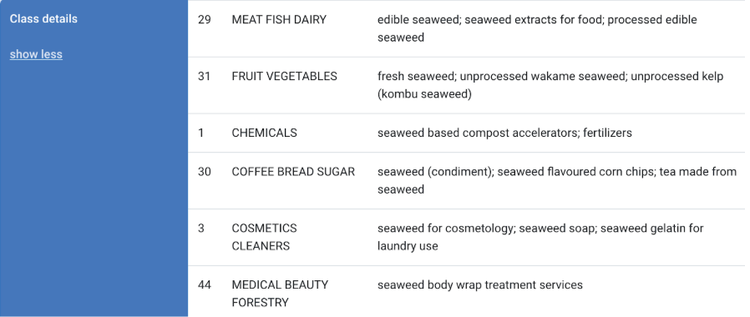Trademark Classes
Trademarks are registered for specific goods and services, all of which fall within specified classes or categories.
IP Offices around the world use the Nice Classification system for classifying goods and services.
Every good or service falls into one of 45 classes (categories). The 45 different classes consist of 34 classes of goods and 11 classes of services.
For example, clothing, shoes and hats are goods which fall into class 25, while plumbing is a service that falls into class 37. Here is a link to the Nice 11 list of classes including broad descriptions of what they cover.
You can apply to register your trademark in one or more of these classes. There is an additional fee for each extra class for which you apply.
Once your trademark has been registered, you will have the exclusive right to use it in that specific country for the goods/services covered – this is the substance of a trademark registration.
Why are Trademark Classes Important?
Trademark classes help define the scope of trademark exclusivity.
Your registered trademark provides exclusive protection for your brand for the goods and services you specify - within their particular classes.
Because some goods and services fall across more than one class, selecting the classes for which you want trademark protection helps to further identify them by grouping them with similar goods or services.
As an example, you may assume that “seaweed” would only fall into one class. However, seaweed and seaweed related products and services fall across multiple classes: edible seaweed and seaweed extracts fall into class 29, while seaweed for composts and fertilizers fall into class 1. If you’re in the health and beauty business and you want protection for your brand for seaweed body treatment services, those services would fall into class 44.
To demonstrate further, here’s a list of classes that cover seaweed-related goods and services:
Classes help the Trademark Office assess whether two trademarks conflict
When you submit your trademark application, a trademark examiner at the Trademark Office will consider whether your trademark is likely to conflict with an existing trademark. (Your trademark must not be identical or confusingly similar to a prior trademark which covers the same or similar goods or services.)
The use of a classification system helps the Trademark Office evaluate the similarity between your new trademark and those already registered and whether consumers are likely to be confused about the origin of the goods or services.
The Trademark Office may allow applications for identical or similar trademarks to those already registered if they cover sufficiently different goods or services. For example, in Australia, DASH has been registered as a trademark by a number of different entities in the following classes:
Class 3 for cleaning products
Class 9 for pet grooming services
Class 10 for medical devices
Class 12 for caravans
Class 31 for seeds
Class 33 for wine
Class 37 for cleaning services
The same or a similar trademark may in certain instances also be registered within one class, as long as consumers are unlikely to be confused about the origin of the goods and/or services provided by the different owners.
Tips for selecting classes “lighting fast” with Trademarks Online
Faced with a list of 45 classes, it’s not always easy to select the most suitable trademark classes that apply to your business. A good tip is to first conduct a trademark name search for your competitors’ trademarks. This will show you have other players in your industry have classified and registered their goods and services and give you some ideas about your own.
The good news for users of Trademarks Online when it comes to choosing classes is that we’ve captured the mind of a trademark attorney in our AI-powered software! Our intelligent online trademark application platform makes selecting classes for your goods and services “hassle-free and lightning fast”.
Simply type in your key goods (or services) and in one click our system lists all the potentially relevant goods and services, including their possible classes. All you have to do is to select the items you want to include in your trademark protection.
Here are some questions to consider when figuring out what your key goods or services are:
What products will people buy from me? (These are your key goods, eg “sugar” or “soap”)
What will people hire me to do? (These are your key services, eg “painting” or “photography”)
While you should bear in mind that there is an additional fee for each trademark class on application, you shouldn’t let this prevent you from making sure you get the most comprehensive trademark protection you can. Although it’s possible to register a trademark in a new class at a later date, there’s always a risk that someone else might beat you to it and block you from accomplishing this in the future. It’s best to aim for maximum trademark protection at the outset.


